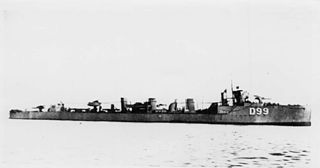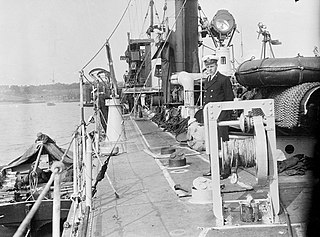
The M29 class comprised five monitors of the Royal Navy, all built and launched during 1915.

The first HMS Zulu was a Tribal class destroyer launched 16 September 1909 at Hawthorn Leslie Shipyard and commissioned in March 1910. She was mined during the First World War, on 27 October 1916 off Dover in a minefield lain by the Imperial German submarine UC-1. Her stern was blown off and sank, but the forward section remained afloat. It was towed into port and attached to the stern of Nubian, which had been torpedoed, to form a new destroyer named HMS Zubian.

HMS Zubian was a First World War Royal Navy Tribal-class destroyer constructed from the forward end of HMS Zulu and the rear and mid sections of HMS Nubian. These two destroyers had been badly damaged in late 1916, and rather than scrapping both hulls at the height of World War I, the Admiralty ordered that they be rebuilt as the composite Zubian and put back into service. She was commissioned into the fleet in June 1917. The name Zubian is a portmanteau of the names of the original ships.

The Abercrombie class of monitors served in the Royal Navy during the First World War.

The Erebus class of warships was a class of 20th century Royal Navy monitors armed with a main battery of two 15-inch /42 Mk 1 guns in a single turret. It consisted of two vessels, Erebus and Terror, named after the two ships lost in the Franklin Expedition. Both were launched in 1916 and saw active service in World War I off the Belgian coast. After being placed in reserve between the wars, they served in World War II, with Terror being lost in 1941 and Erebus surviving to be scrapped in 1946.

The Lord Clive-class monitor, sometimes referred to as the General Wolfe class, were ships designed for shore bombardment and were constructed for the Royal Navy during the First World War.

The Marshal Ney class was a class of monitor built for the Royal Navy during the First World War.

HMS Swiftsure, originally known as Constitución, was the lead ship of the Swiftsure-class pre-dreadnought battleships. The ship was ordered by the Chilean Navy, but she was purchased by the United Kingdom as part of ending the Argentine–Chilean naval arms race. In British service, Swiftsure was initially assigned to the Home Fleet and Channel Fleets before being transferred to the Mediterranean Fleet in 1909. She rejoined Home Fleet in 1912 and was transferred to the East Indies Station in 1913, to act as its flagship.

HMS Laforey was the lead ship of her class of destroyer built for the Royal Navy. Launched a year before the First World War began, she was attached to the Dover Patrol. Laforey saw action in several engagements with German torpedo boats, including the Battle off Noordhinder Bank and the action of 17 March 1917. Laforey was sunk in 1917 by a British mine after escorting several freighters to France. She was named for Francis Laforey, captain of HMS Spartiate at the Battle of Trafalgar in 1805.

HMS Marshal Ney was the lead ship of her class of two monitors built for the Royal Navy during the First World War. Laid down as M13, she was renamed after the French field marshal of the Napoleonic Wars Michel Ney. After service in the First World War, she became a depot ship and then an accommodation ship. Between 1922 and 1947, she was renamed three times, becoming successively Vivid, Drake and Alaunia II. She was scrapped in 1957.

HMS General Craufurd was the one of eight Lord Clive-class monitors built for the Royal Navy during World War I. Their primary armament was taken from obsolete pre-dreadnought battleships. The ship spent the war in the English Channel bombarding German positions along the Belgian coast as part of the Dover Patrol. She participated in the failed First and Second Ostend Raids in 1918, bombarding the defending coastal artillery as the British attempted to block the Bruges–Ostend Canal. Later that year General Craufurd supported the coastal battles during the Hundred Days Offensive until the Germans evacuated coastal Belgium in mid-October. The ship was decommissioned almost immediately after the war ended the following month, but she was reactivated in 1920 to serve as a gunnery training ship for a year. General Craufurd was sold for scrap in 1921.

HMS Marshal Soult was a Royal Navy Marshal Ney-class monitor constructed in the opening years of the First World War. Laid down as M14, she was named after the French general of the Napoleonic Wars Marshal Nicolas Jean de Dieu Soult. She served in both World Wars and was decommissioned in 1946.
HMS Faulknor was a British destroyer of the First World War. She was purchased by the Royal Navy whilst still under construction in Britain for the Chilean Navy who had ordered her in 1912 as part of the Almirante Lynch class. She was renamed after the Faulknor family of British nineteenth century naval officers.

The Humber-class monitors were three large gunboats under construction for the Brazilian Navy in Britain in 1913. Designed for service on the Amazon River, the ships were of shallow draft and heavy armament and were ideally suited to inshore, riverine and coastal work but unsuitable for service at sea, where their weight and light draft reduced their speed from a projected twelve knots to under four. The class comprised Humber, Mersey and Severn. All three were taken over by the Royal Navy shortly before the outbreak of the First World War and were commissioned as small monitors. All three saw extensive service during the war and were sold in 1919.
HMS Laverock was a Laforey-class destroyer of the Royal Navy. She was launched in 1913 and entered service in October 1914. Laverock served through the First World War, operating with the Harwich Force and in the English Channel. She was sold for scrap in 1921.
HMS Murray was a Royal Navy Admiralty M-class destroyer. Ordered before the outbreak of war, she was therefore the first of her class to enter operation during the early months of the First World War. She was also the first vessel of the Royal Navy to carry the name HMS Murray.

HMS Manly was a Yarrow M-class destroyer of the British Royal Navy. Built by the Scottish shipbuilder Yarrow between 1913 and 1914, Manly served during the First World War. She formed part of the Harwich Force in the early years of the war, and then later in the English Channel as part of the Dover Patrol taking part in the Zeebrugge Raid in 1918. She survived the war, and was sold for scrap in 1920.

HMS Landrail was a Laforey-class destroyer of the British Royal Navy. The Laforey class was the class of destroyers ordered under the Royal Navy's 1912–1913 construction programme, which were armed with three 4-inch (102 mm) guns and four torpedo tubes and were capable of 29 knots. The ship, which was originally to be named Hotspur but was renamed before launch, was built by the Scottish shipbuilder Yarrow between 1912 and 1914,

HMS Moorsom was an Admiralty M-class destroyer which served in the Royal Navy during the First World War. The M class were an improvement on the preceding L class, capable of higher speed. Moorsom, the first ship to enter navy service to be named after Admiral Sir Robert Moorsom, was launched in December 1914, initially serving as part of the Grand Fleet before being transferred to the Harwich Force the following year. Briefly rejoining the Grand Fleet, the destroyer saw service in the Battle of Jutland in 1916 supporting the British battlecruisers and received hits from a battleship of the German High Seas Fleet. Moorsom also undertook other duties, including escorting the troop ship Mauretania in June 1915 and the minelayer Princess Margaret in August 1915 and November 1916. Placed within the Dover Patrol, the destroyer formed part of the cover for monitors including Erebus and Terror on attacks on Ostend and Zeebrugge in May and June 1917, and April and May 1918. After the Armistice, the destroyer was placed in reserve and subsequently sold to be broken up in November 1921.

HMS Morris was an Admiralty M-class destroyer which served with the Royal Navy during the First World War. The M class were an improvement on the preceding L class, capable of higher speed. The ship, the only vessel to be named Morris to serve with the Royal Navy, was launched on 19 November 1914. Joining the Grand Fleet as part of a new flotilla, the destroyer was soon in action, serving as part of a destroyer screen during the Battle of Dogger Bank in January 1915 and an escort to the minelayer Princess Margaret during a skirmish with German torpedo boats eight months later. At the Battle of Jutland in 1916, the destroyer was a crucial part of the flotilla that drove the German torpedo boats away from the British battlecruisers. Morris received no hits during these confrontations. The destroyer assisted in the rescue of survivors from the R-class destroyer Simoom and the recovery of the damaged flotilla leader Botha in 1917. The ship also undertook general duties including escorting merchant ships, minelayers, monitors, and the seaplane carrier Vindex. After the armistice that ended the war, the destroyer was considered superfluous to requirements, Initially placed in reserve, Morris was decommissioned and, on 8 November 1921, sold to be broken up.















